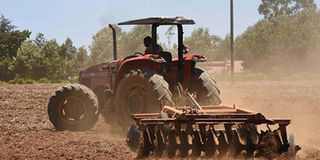Food sufficiency will come through diversification, value addition

A worker tills a farm in Moiben, Uasin Gishu County, on April 8, 2020. PHOTO | FILE | NATION MEDIA GROUP
What you need to know:
- One of the key changes is to weaken the hold of government on production and marketing of maize, which has often ended up being abused and crowding out the private sector.
- Going forward, the government will focus on its key role, that of creating an enabling environment for producers and traders to make and execute commercial decisions.
Agriculture is key to Kenya's economy, employs more than 40 per cent of the total population and more than 70 per cent of Kenya's rural people, yet contributing only 26 per cent of the Gross Domestic Product (GDP).
At the same time, Kenya has had sustained high population growth over the last 50 years, nearly six-fold increase since 1963, and projected to 64 million by 2030. However, food growth index of staple cereals from 1963 to 2017 was 2.2 per cent.
Consequently, as more Kenyans share nearly the same amount of food as before, communities are becoming food deficient.
Furthermore, and as a result of the population increase, land parcels in the traditional crop growing areas are decreasing in size, affecting food production.
Against this background, President Uhuru Kenyatta committed the government to address the frequent chronic food insecurity by adopting a road map to achieving 100 per cent food and nutrition safety by the year 2022 as one of the 'Big Four Development Agenda'.
Sadly, the national conversation around food and agricultural reforms often invariably turns to maize. Our route to food security will in the end come from a broader approach that promotes diversification and value-addition.
More so, time is ripe to shift from the false notion of high versus low potential agricultural areas.
FLAGSHIP PROJECTS
Rather, focus on the broader nutrition and food security, which distinguishes parts of Kenya by their potential or suitability for distinct agricultural enterprises (crops, livestock and fisheries) depending on climatic and soil type zones.
The Ministry of Agriculture has initiated sector reforms that are anchored on the Agricultural Sector Transformation and Growth Strategy (ASTGS) 2019-2029, which aims to inform and bring to life the food security pillar of the President’s Big Four Agenda.
The reforms will boost production, trade and consumption of staples beyond maize, and therefore boost the deriving incomes and benefits.
This is at the heart of the ongoing restructuring of a sector that is so key to the nation's economy yet remains largely untapped.
The ASTGS details nine flagship projects aimed at achieving three main objectives: increasing farmer incomes, increasing overall agricultural output and value-addition, and boosting household food resilience.
Therefore, the ASTGS aims at bringing more land under large-scale food production, linking farming with small and medium enterprise so as to professionalise it, bringing more crops under irrigation, and boosting extension by hiring young graduates of agriculture. It will also shore up marketing by way of cooperatives as producers enjoy the economies of scale.
WAKE-UP CALL
One of the key lessons the coronavirus crisis has taught countries across the globe is the need for food sufficiency.
Never has the need for the nation to produce its own food been more urgent as it is now. With movements curtailed and with countries adopting inward-looking policies, we have no choice but to make the most of what we have and become self-sufficient.
And for us to get the most out of the ongoing changes, we have to address the sector in its entire value chain - right from production to marketing - even though our methodology may be multistage.
One of the key changes is to weaken the hold of government on production and marketing of maize which, though well-meant, has often ended up being abused and crowding out the private sector.
It is for this reason that the government has pronounced itself that it is no longer in the business of buying and selling maize and fertiliser, whether locally or imported.
Going forward, the government will focus on its key role, that of creating an enabling environment for producers and traders to make and execute commercial decisions, while ensuring that commercial interest, especially on imports, don’t disadvantage local producers and consumers.
NCPB REVAMP
To this end, the government has established a revamped Food Balance Sheet Committee to collect, analyse, forecast and publicly share food supply and consumption data.
Therefore, open an evidence-based decisioning on National Food Reserve and food trade.
The National Cereals and Produce Board (NCPB) has rightly caught the attention of sector stakeholders because of the central role it has played over the years, particularly regarding marketing.
Many changes have occurred in the way food is produced and traded since the formation of NCPB in 1979.
The ongoing reforms will inevitably require far radical institutional reorientation that include vetting and training of capacity of NCPB officers to new roles.
Mr Munya, MGH is the Cabinet Secretary for Agriculture, Livestock, Fisheries and Cooperatives





